Disclosure: We may earn commissions if you purchase products after clicking on a link from our site.
Do you have a riflescope and need to sight it in? How to sight in a scope is a very important aspect of setting up your rifle for hunting. It is a step-by-step procedure that is not difficult. In this article, we discuss the procedure to sight in a scope and get it ready to take down the prey this hunting season.
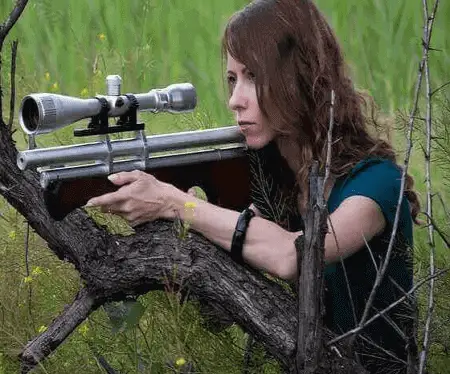
Table of Contents
How To Sight In A Scope
1. Mount The Base
Install the mounting base of your scope to the rifle. You can read about how to mount a scope on your rifle in this article. Mounting the base is a crucial step in the process of sighting in your scope for optimal accuracy and precision.
The base serves as the foundation for attaching the scope to your firearm securely. It is essential to select a high-quality base that matches the mounting system of your rifle and is compatible with your scope. Before mounting the base, ensure that the rifle’s receiver is clean and free from any dirt or debris that could affect the mounting process.
Next, carefully align the base with the pre-drilled holes on the receiver, making sure it is positioned correctly for proper eye relief and alignment with the bore axis. Use the appropriate tools to securely fasten the base to the rifle, ensuring that each screw is tightened evenly and to the manufacturer’s specifications. A properly mounted base provides a stable platform for your scope, allowing for consistent and reliable performance when sighting in and shooting your firearm.
2. Attach The Rings
Then attach the rings to the base. Make sure that the rings are aligned with the mounting system. Then mount the scope onto the rings and tighten the screws. Don’t overtighten the screws as this can damage the scope.
Attaching the rings is a critical step in the process of sighting in your scope, as they secure the scope to the base mounted on your firearm. After mounting the base, select the appropriate rings that match the diameter of your scope tube and are compatible with the mounting system of your rifle.
Place the bottom half of each ring onto the base, ensuring that they are aligned with the mounting holes and spaced evenly apart to provide adequate support for the scope. Carefully lower the scope into the rings, making sure it is positioned correctly for proper eye relief and alignment with the bore axis. Then, place the top half of each ring over the scope tube and align them with the bottom halves.
Use the provided screws or fasteners to secure the rings tightly, but be cautious not to over-tighten them, as this could damage the scope. Once the rings are securely attached, check the alignment and ensure that the scope is level before proceeding to the next step of sighting in your firearm.
3. Mount The Scope
Align the scope with the mounting base. You can get this done by looking through the scope and verifying that the crosshairs are lined up with the mounting base. Once the scope is aligned, you attach it to the mounting base.
Mounting the scope is a crucial step in the process of sighting in your scope, as it ensures proper alignment and stability for accurate shooting.
To begin, select the appropriate scope and mounting system for your firearm, ensuring compatibility with both the rifle and the type of shooting you’ll be doing. Start by attaching the scope rings to the scope base or rail, ensuring they are evenly spaced and aligned with the mounting holes. Then, carefully place the scope into the rings, making sure it is positioned correctly for optimal eye relief and alignment with the bore axis of the rifle.
Once the scope is in place, tighten the mounting screws or fasteners gradually and evenly to secure the scope in position. Be cautious not to over-tighten, as this could damage the scope or affect its alignment. Once the scope is securely mounted, you can proceed to the next steps of leveling and zeroing the scope to ensure precise and consistent accuracy when shooting.
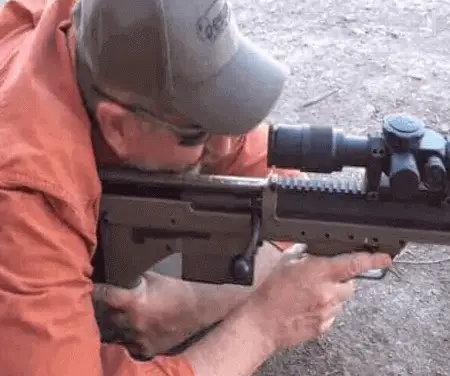
3. Adjust The Eye Relief
Adjust the eye relief. Eye relief is the distance between your eye and the scope. Adjust the eye relief by looking through the scope and moving it forward or backward until you get a clear view. Eye relief affects accuracy; hence, you must get it correct.
Adjusting the eye relief is an essential step when sighting in your scope, as it ensures a comfortable and safe shooting experience while maintaining proper alignment with the target. Eye relief refers to the distance between your eye and the rear lens of the scope, and it should be adjusted to accommodate your individual shooting position and firearm setup.
To adjust the eye relief, first, position yourself in your preferred shooting stance and mount the rifle to your shoulder in a natural and comfortable position. Then, adjust the scope forward or backward within the scope rings until you achieve a clear and full field of view through the scope without any black edges or shadowing.
Ensure that there is enough space between your eye and the scope to prevent injury from recoil while maintaining a consistent sight picture. Once you’ve adjusted the eye relief to your satisfaction, securely tighten the scope rings to hold the scope in place, ensuring that it remains stable and aligned throughout your shooting sessions.
4. Sighting In The Rifle
Once the scope is mounted, the next step is to sight it in. There are many ways to sight in a rifle. You can sight it in by shooting at a target and carefully making adjustments to the scope until it is hitting the center of the target.
Sighting in the rifle is a crucial step in the process of sighting in your scope, as it ensures that your shots will be accurately placed on target. To sight in the rifle, begin by securing it in a stable shooting position, such as using a rifle rest or sandbags to support the barrel and stock.
Next, choose a target at an appropriate distance for sighting in your scope, typically around 100 yards for most hunting rifles. Aim at the target using your iron sights or an initial estimate with the scope, and fire a carefully aimed shot. Then, examine the point of impact on the target and adjust the windage and elevation turrets on the scope accordingly to move the point of impact to the desired point of aim.
Make incremental adjustments to the scope based on the initial shot placement until you achieve consistent and accurate shots on target. It may take several rounds and adjustments to properly sight in the rifle and scope combination, so be patient and meticulous throughout the process to ensure optimal accuracy and performance.
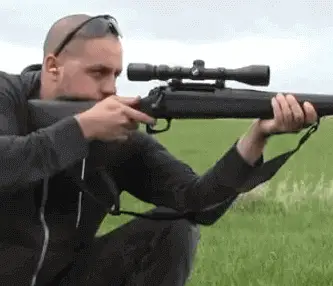
Types of Riflescopes
1. Fixed Scopes
Fixed scopes are one of the most basic types of riflescopes. The magnification level for a fixed scope is fixed; it is not variable. You can’t zoom in and zoom out to get a better view. As a result of this limitation, fixed scopes are not expensive.
Fixed scopes are a type of riflescope characterized by a single magnification level, meaning they do not offer variable magnification settings like their counterparts, the variable scopes. Fixed scopes typically have a specific magnification power, such as 4x, 6x, or 10x, which remains constant throughout their use.
These scopes are known for their simplicity, reliability, and ruggedness, making them popular choices for shooters who prefer a straightforward optic without the complexity of adjusting magnification levels. Fixed scopes are often favored for hunting at consistent distances or shooting applications where a specific magnification level is preferred. They offer clear and crisp sight pictures and are less prone to mechanical failures due to their simpler design.
However, the lack of variable magnification limits their versatility in certain shooting scenarios where different magnification levels may be required. Despite this limitation, fixed scopes remain a popular choice among shooters who prioritize durability and reliability in their optics.
2. Variable Scopes
A variable scope features a variable magnification. Variable scopes feature a number followed by the letter “X” in their names. An example is 3-9X20. The 3-9X is the magnification and the 20 represents the size of the objective lens.
Variable scopes are a type of riflescope distinguished by their ability to adjust magnification levels, offering users the flexibility to zoom in and out to varying degrees. Unlike fixed scopes, which have a single magnification setting, variable scopes feature a range of magnification options, typically expressed as a series of numbers separated by a hyphen (e.g., 3-9x).
This indicates that the scope can magnify the target image from three times its original size to nine times its size, providing versatility for different shooting situations. Variable scopes are highly adaptable and suitable for various applications, including hunting, target shooting, and tactical operations, where engagement distances may vary. They offer shooters the ability to zoom in for precise shots at long distances or zoom out for a wider field of view when tracking moving targets or shooting at closer ranges.
Variable scopes often feature adjustable turrets or dials for fine-tuning elevation and windage adjustments, allowing shooters to compensate for environmental factors and ballistic trajectories. While variable scopes offer increased versatility, they can be more complex and may require additional adjustments and considerations compared to fixed scopes. Overall, variable scopes provide shooters with the flexibility to tailor their optics to specific shooting scenarios, making them popular choices among discerning marksmen.
3. Night Vision Scope
Night vision scope is designed specifically for usage at night when you are in low-light situations. it features an infrared illuminator built-in that gives you the ability to see in low-light conditions. We did a review of the best night vision binoculars that you can read from this link.
Night vision scopes are a specialized type of riflescope designed to enhance visibility in low-light or nighttime conditions, allowing shooters to accurately aim and target objects in the dark. Unlike traditional scopes, night vision scopes utilize image intensifier technology to amplify ambient light, including infrared light, moonlight, and starlight, to produce a visible image.
This technology converts photons of light into electrons, which are then amplified and converted back into visible light, resulting in a green-tinted image that is visible through the scope’s eyepiece. Night vision scopes are commonly used by hunters, law enforcement personnel, and military operators for nighttime surveillance, target acquisition, and shooting activities.
They provide users with the ability to detect and identify targets at extended ranges in low-light conditions, increasing situational awareness and effectiveness during nocturnal operations. Night vision scopes are available in various configurations, including standalone devices that can be mounted on rifles or as attachments for existing daytime scopes, offering versatility and adaptability to different shooting setups.
While night vision scopes offer significant advantages for nighttime shooting, they can be expensive and may require additional accessories such as infrared illuminators for optimal performance in complete darkness. Overall, night vision scopes provide shooters with the capability to effectively engage targets in low-light environments, making them essential tools for individuals conducting operations after dark.

4. Tactical Scopes
Tactical scopes are purposely designed for a specific type of shooting. They are designed to extend the engagement range for infantry troops.
Tactical scopes are specialized riflescopes designed for military, law enforcement, and civilian shooters who require precise aiming and target acquisition capabilities in dynamic and challenging environments. Unlike traditional hunting scopes, tactical scopes are engineered with features optimized for tactical applications, including rugged construction, tactical turrets, and enhanced reticles.
These scopes often feature high-quality optics with variable magnification to allow shooters to engage targets at various distances with clarity and precision. Tactical scopes commonly incorporate illuminated reticles with multiple aiming points or hash marks for quick and accurate holdovers, especially in low-light conditions or when engaging moving targets.
Additionally, tactical scopes may include features such as parallax adjustment, zero-stop turrets, and bullet drop compensation (BDC) reticles to enhance accuracy and ease of use in the field. The durability and reliability of tactical scopes are paramount, with many models being shockproof, waterproof, and fog-proof to withstand harsh environmental conditions.
Overall, tactical scopes are versatile tools designed to meet the demands of modern shooters engaged in tactical operations, competitive shooting sports, and long-range precision shooting, providing them with the necessary optics to excel in challenging scenarios.
5. Long-Range Scopes
Long-range scopes are a broad category of scopes that includes competition scopes and sniper scopes. Most long-range scopes feature a variable magnification although you can find some that are fixed long-range scopes.
Long-range scopes are specialized optics designed for shooters who engage targets at extended distances, typically beyond 500 yards. These scopes feature high-quality lenses and precision engineering to provide exceptional clarity, resolution, and magnification, allowing shooters to accurately observe and engage distant targets. Long-range scopes often have variable magnification settings, enabling shooters to zoom in on distant objects for precise aiming and target identification.
Additionally, these scopes may incorporate features such as adjustable parallax, turret-mounted elevation and windage adjustments, and specialized reticles with bullet drop compensation (BDC) or mil-dot markings to compensate for bullet trajectory and wind drift at long distances. Long-range scopes are essential tools for precision shooters, competitive marksmen, and hunters pursuing game at extended ranges, offering the optical performance and ballistic capabilities needed to achieve consistent accuracy at long distances.
6. Hunting Scopes
Hunting scopes are robust and usually weather-resistant. They usually have a 20x magnification or lower. It is designed to create a bright and clear image no matter what is the weather condition.
Hunting scopes are essential tools for hunters seeking accuracy and precision in various hunting conditions. These scopes are specifically designed to enhance a hunter’s ability to acquire and aim at game animals effectively.
Hunting scopes come in a range of magnifications suited for different hunting environments, from dense forests to wide-open plains. They often feature a rugged construction to withstand rough handling and adverse weather conditions encountered in the field.
Additionally, hunting scopes may include features like illuminated reticles for low-light visibility, adjustable parallax for focusing at different distances, and fast-focus eyepieces for quick target acquisition. Some hunting scopes also offer ballistic reticles or turret adjustments tailored to specific hunting cartridges, enabling hunters to compensate for bullet drop and wind drift at various distances. With their versatility and performance-enhancing features, hunting scopes are indispensable tools for hunters pursuing game animals with accuracy and confidence.
7. Competition Scopes
Competition scopes feature a high magnification. They are big and not very durable. Competition scopes don’t feature much light transition. They have magnifications up to 40x.
Competition scopes are specialized optics designed for use in shooting competitions, where precision and accuracy are paramount. These scopes are engineered to provide shooters with exceptional clarity, resolution, and magnification capabilities to precisely place shots on target at various distances.
They often feature high-quality glass and lens coatings to optimize light transmission and minimize glare, ensuring clear sight pictures even in challenging lighting conditions. Competition scopes typically offer a wide range of magnification settings, allowing shooters to zoom in on distant targets for precise aiming. They may also include features such as adjustable parallax, zero-stop turrets, and fine-tuned reticles to accommodate different shooting disciplines and preferences.
Additionally, competition scopes often have rugged construction to withstand the rigors of competitive shooting environments and may come with features like zero-reset turrets for quick adjustments between stages. With their advanced optical performance and specialized features, competition scopes are essential tools for serious competitors looking to gain a competitive edge on the firing line.
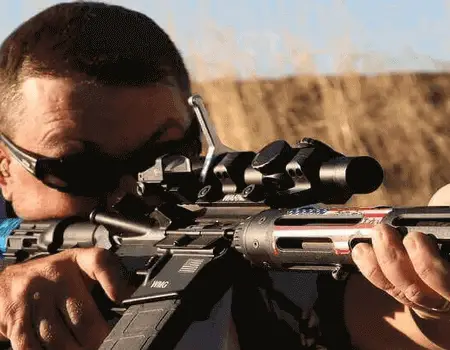
8. Red Dot Scopes
Red dot scopes usually have little or no magnification. It is often used in close-quarter shooting. If you look through a red dot scope, you will just see a single red dot in the center of the optic. That single red dot is your aiming point. A review of the best red dot scopes on the market can help you find the right red dot scope if you are looking for one.
Red dot scopes, also known as reflex sights, are a type of riflescope designed for quick target acquisition and close- to mid-range shooting. Unlike traditional scopes with magnification, red dot sights project an illuminated aiming point onto a lens in the sight’s field of view.
This aiming point, often a small red dot or reticle, allows shooters to align their shot without needing to align multiple crosshairs or adjust for parallax. Red dot scopes are prized for their simplicity and ease of use, making them popular choices for tactical applications, such as military and law enforcement operations, as well as for recreational shooting, including hunting and competitive shooting sports.
They offer unlimited eye relief, meaning shooters can maintain a comfortable shooting position regardless of their distance from the sight, and they excel in fast-paced shooting scenarios where quick target acquisition is critical. Some red dot scopes offer additional features like variable brightness settings, multiple reticle options, and built-in laser or infrared capabilities for enhanced versatility in various shooting conditions. With their lightweight, compact design and intuitive operation, red dot scopes are versatile optics suitable for a wide range of shooting disciplines and environments.
9. Sniper Scopes
Sniper scopes don’t feature a high magnification. These scopes feature the mil-dot reticle that provides the shooter with information such as distances, windages, etc. They feature fine adjustment turrets that allow for precise movements in little increments as accuracy is the most important feature for a sniper.
Sniper scopes are specialized riflescopes designed for precision shooting at long ranges, typically used by military snipers, law enforcement marksmen, and competitive shooters. These scopes feature high magnification levels, often ranging from 10x to 25x or more, allowing shooters to accurately engage targets at distances exceeding 1000 yards.
Sniper scopes are equipped with large objective lenses to gather maximum light, ensuring clear and bright images even in low-light conditions. They also incorporate features such as mil-dot or MOA reticles, which provide precise aiming points and allow for range estimation, windage and elevation adjustments, parallax adjustment, and zero-reset turrets for quick and easy sight-in adjustments.
Additionally, many sniper scopes are equipped with tactical turrets or zero-stop mechanisms to prevent inadvertent adjustments and maintain zero settings in high-stress situations. These scopes are built to withstand the rigors of field use, with rugged construction, waterproof and fog-proof performance, and shock-resistant housing to ensure reliable operation in harsh environments. Sniper scopes are essential tools for shooters who demand uncompromising accuracy and performance in long-range shooting scenarios, where precise shot placement is critical.
10. Scout Scopes
Scout scopes feature low magnification usually between 2x and 8x. They are simple to operate with limited adjustability. Scout scopes are similar to tactical scopes and are used by hunters and the military.
Scout scopes, also known as forward-mounted scopes, are a specialized type of riflescope primarily designed for scout rifles and similar firearms. Unlike traditional scopes, scout scopes are mounted forward of the rifle’s action, typically above the barrel, allowing for both eyes to remain open during aiming.
This unique positioning provides shooters with a wider field of view and enhanced situational awareness, making them ideal for quick target acquisition and engaging moving targets. Scout scopes typically feature low to moderate magnification levels, usually ranging from 1x to 4x, to maintain a wide field of view and facilitate fast target acquisition at close to medium ranges. They often incorporate long eye relief, allowing shooters to maintain a comfortable shooting position even with the scope mounted forward on the rifle.
Additionally, scout scopes typically have compact and lightweight designs to minimize added weight and bulk to the firearm. While scout scopes may sacrifice some magnification compared to traditional scopes, their versatility and rapid target acquisition capabilities make them well-suited for hunting in dense brush or wooded areas, as well as for tactical applications where speed and agility are paramount.
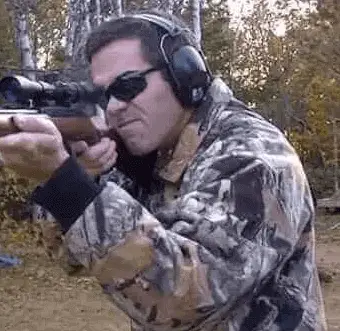
Tools To Sight In A Scope
1. Torque wrench or Socket heads
A torque wrench or socket heads are essential tools for properly mounting and adjusting a riflescope during the sighting-in process. When mounting the scope onto the rifle, it’s crucial to apply consistent and even torque to the mounting screws to ensure a secure and stable attachment.
Over-tightening can potentially damage the scope or rifle, while under-tightening may lead to shifting or movement under recoil. A torque wrench allows shooters to apply precise torque settings recommended by the scope manufacturer, ensuring the mounting screws are tightened to the appropriate specifications.
Additionally, socket heads are used to adjust windage and elevation turrets on the scope to zero the point of impact with the point of aim. These tools provide the necessary leverage and precision to make minute adjustments to the scope’s internal mechanisms, allowing shooters to fine-tune their aim and achieve optimal accuracy. Whether mounting a new scope or making adjustments to an existing one, a torque wrench and socket heads are indispensable tools for any shooter looking to properly sight in their rifle scope.
2. Leveling Kit
A leveling kit is a crucial tool for ensuring the proper alignment of a rifle scope during the sighting-in process. Proper alignment is essential to achieve accurate and consistent shot placement.
The leveling kit typically includes a small bubble level that attaches to the rifle’s receiver or scope rail. By placing the bubble level on a flat surface of the rifle, shooters can ensure that the rifle is perfectly level both horizontally and vertically.
This step is crucial because even slight misalignments can result in significant errors in point-of-impact at longer distances. By using a leveling kit, shooters can eliminate the potential for canting errors and ensure that the rifle and scope are perfectly aligned with the target. This ensures that adjustments made to the scope’s windage and elevation turrets translate accurately to changes in the point of impact downrange, ultimately leading to more precise shooting and improved accuracy.
3. Gun Stabilizer
A gun stabilizer serves as a valuable tool during the process of sighting in a scope, especially for shooters seeking enhanced stability and accuracy. This device typically attaches to the rifle’s forend or barrel and provides additional support to minimize movement and recoil.
By reducing unwanted movement, a gun stabilizer helps shooters maintain a steady aim, resulting in more consistent and precise shots. This stability is crucial when zeroing in a scope, as even slight movements can affect the accuracy of adjustments made to windage and elevation settings.
Additionally, a gun stabilizer can help shooters stay on target for extended periods, reducing fatigue and allowing for more focused shooting sessions. Overall, incorporating a gun stabilizer into the sighting-in process can lead to improved accuracy and confidence in rifle performance.
4. Bore setter
A bore setter is a highly useful tool for accurately sighting in a scope, particularly for shooters looking to ensure perfect alignment between the rifle bore and the scope’s reticle. This device is designed to precisely center the scope’s crosshairs with the rifle’s bore, eliminating any potential offset or misalignment that could affect accuracy.
The bore setter typically attaches to the rifle’s barrel and provides a reference point for aligning the scope’s reticle. By aligning the reticle with the bore setter, shooters can be confident that their scope is perfectly aligned with the rifle barrel, optimizing accuracy and precision.
This ensures that shots land exactly where intended, whether on the range or in the field. Using a bore setter as part of the sighting-in process helps shooters achieve consistent and reliable performance from their rifles and scopes, enhancing overall shooting proficiency and confidence.
The Bottom Line
How to sight in a scope is a methodical process that is not difficult. It is important to get it right as it affects the accuracy of your shooting. It ensures that your shot accuracy will not be impacted by distance. Learning how to sight in a scope is a priceless skill that is easy and quick to learn.
You can also learn how to mount a scope on your rifle from this article. We reviewed the best hunting riflescopes that you can read if you are interested in riflescopes.